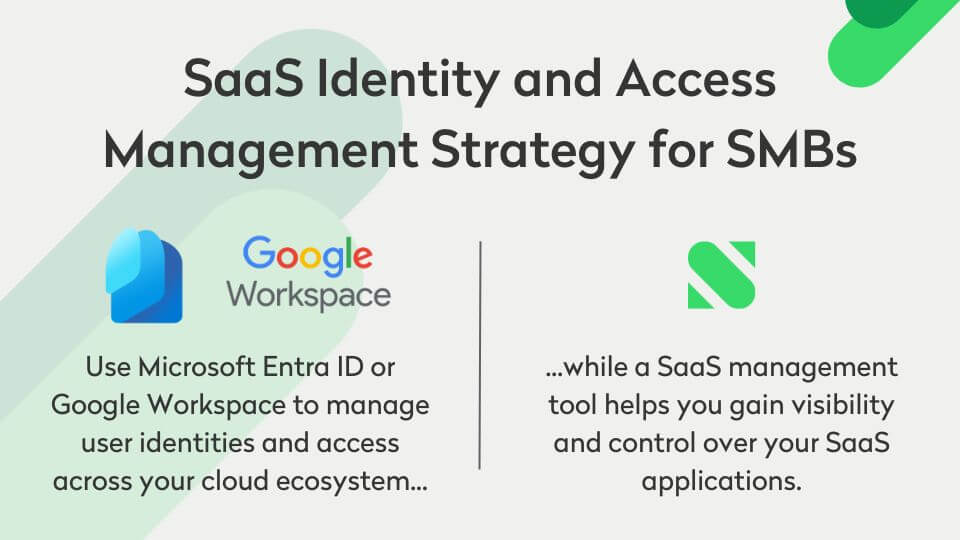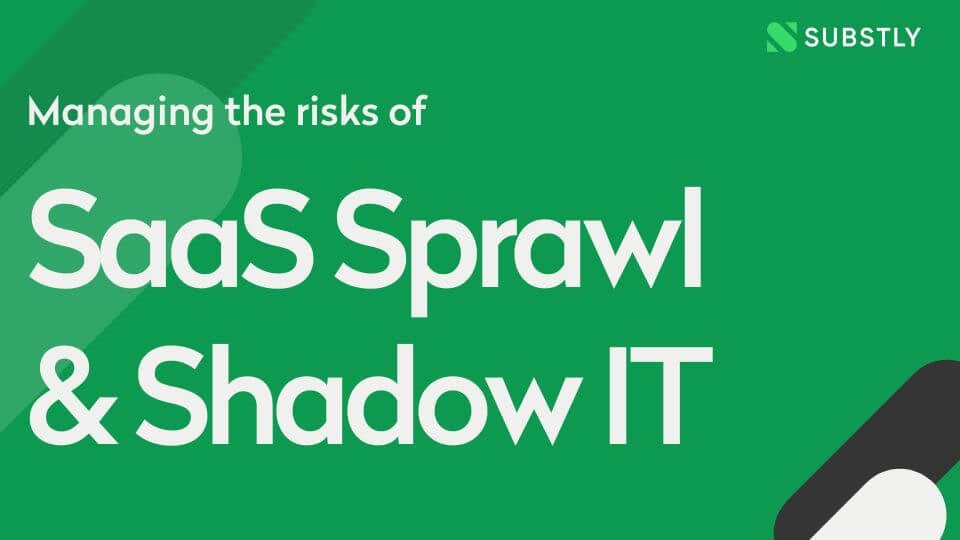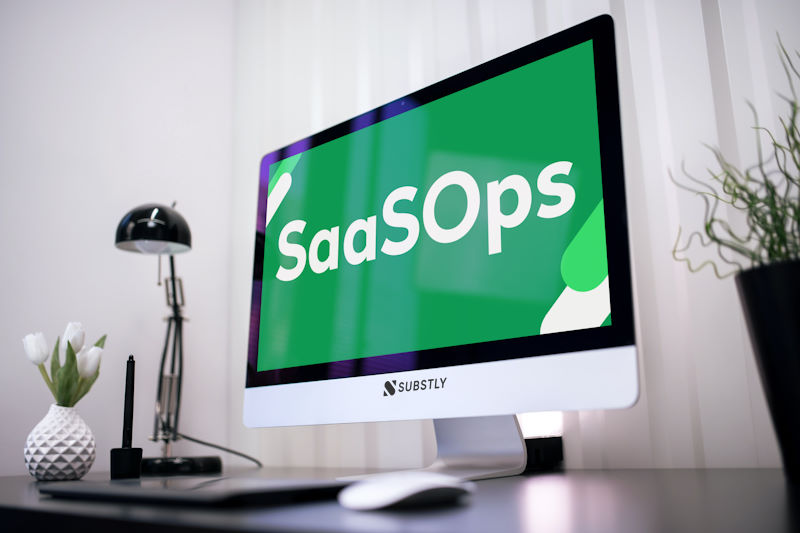Table of Contents
What is Identity and Access Management (IAM)?
Understanding IAM in the Context of SaaS Tools
The Growth of Shadow IT and Its Impact
Security Measures for Protecting Sensitive Data
Saas Identity and Access Management (SaaS IAM)
Proactive Steps Businesses Can Take
SaaS IAM for Small and Midsize Businesses
Key Takeaways
- Identity and Access Management (IAM) is essential in modern IT environments as businesses continue to adopt new tools and cloud services.
- Proactive measures are key for secure SaaS usage
- There are substantial discrepancies in how to apply IAM in small and large companies.
- The synergy between MS Entra ID (formerly Azure AD) or Google Workspace and a SaaS management platform provides a comprehensive IAM solution for SMBs without the high costs associated with high-end IAM tools.
In today's bustling digital landscape, companies are spoilt for choice regarding software tools and cloud services. These SaaS applications, or Software-as-a-Service solutions, have transformed how businesses operate, offering cost-effective and user-friendly platforms that streamline tasks and boost productivity.
However, this profusion of options has also given rise to several challenges, notably shadow IT and SaaS sprawl, which can lead to data breaches and other security concerns. Gartner states that if you fail to manage SaaS life cycles centrally, you are five times more susceptible to security breaches.
In this ever-evolving business world, SaaS Identity and Access Management is paramount for safeguarding sensitive information and maintaining cloud security.
What is Identity and Access Management (IAM)?
IAM stands for Identity and Access Management. It is a framework and set of technologies used to manage and control user identities, their authentication, and their access to various resources within the organization's IT environment.

The primary goal of IAM is to ensure that the right individuals have the correct level of access to the right resources at the right time and for the right reasons.
Understanding IAM in the Context of SaaS Tools
SaaS Identity and Access Management (SaaS IAM) plays a pivotal role in addressing security issues associated with the proliferation of SaaS apps.
IAM ensures that the right individuals have the correct level of access to the right resources. This becomes especially crucial when employees bring their own devices (BYOD) and use various cloud services.
To mitigate the impact of shadow IT, companies need to implement robust IAM solutions tailored to the modern IPaaS (Integration Platform as a Service) landscape.
The Growth of Shadow IT and Its Impact
Shadow IT refers to the practice within an organization where employees, teams, or departments use software, applications, or IT services without the explicit approval or oversight of the organization's IT department or management.
These tools and services are often adopted directly by end-users to meet specific needs or address particular tasks, usually for reasons of convenience or productivity.
A recent study concluded that 65% of SaaS apps were unsanctioned, i.e., users adopted tools without IT's approval or knowledge.
The increase in shadow IT can be attributed to several factors, such as the ease of access and adoption of more tools.
With the simplicity of acquiring and deploying SaaS applications, employees can use tools without formal IT approval. This accessibility has been further accentuated by the shift towards remote work and the use of personal devices.
Employees seek out new tools to enhance their work output; often, the organization does not vet these tools.
Shadow IT is often the result of SaaS sprawl when an organization is growing. This means that the software services used are growing at a pace where it becomes very complex to track manually, often resulting in overlapping functionalities and unnecessary costs.
This results in unmanaged software usage and an increased risk of security breaches and compliance violations, which is especially important to address now since more than 50% of all organizations have seen a rise in cyber attacks after the COVID-19 pandemic.
.jpg?width=600&height=412&name=1mVvtaCblz7%20(4).jpg)
Security Measures for Protecting Sensitive Data
Security is paramount in the modern business world. To safeguard sensitive information, companies should take proactive steps to implement secure practices.
Access controls, multi-factor authentication, and password managers are essential tools.
These security measures ensure that only authorized personnel have access to specific applications and data.
They also mitigate the risk of account takeover, where cybercriminals exploit vulnerabilities in unmanaged SaaS licenses.
But don't forget that one of the most essential tools in risk management and security measures is educating your employees. It is critical to continuously train and inform personnel on data security best protocols, detecting phishing attempts, and reporting suspicious activities.
Saas Identity and Access Management (SaaS IAM)
Saas IAM solutions are becoming increasingly common in managing the growing complexity of SaaS apps.
These solutions provide a centralized way to oversee and control access to various SaaS applications, helping organizations regain control over their technology landscape.
By adopting Saas IAM, companies can effectively monitor user access, manage permissions, and reduce the risks associated with shadow IT.
Proactive Steps Businesses Can Take
To address the challenges posed by shadow IT and SaaS sprawl, businesses should take the following proactive steps:
Develop an IT Governance Framework: Establish clear policies for software procurement, usage, and decommissioning, as well as employee training and awareness guidelines. This framework helps understand SaaS IAM and its role in safeguarding company data. Here is an IT Policy template freebie to get you started.
Conduct Regular Software Audits: Regularly audit software usage across the organization to identify unapproved applications and ensure compliance with established policies. This is particularly important for minimizing security risks.
Implement a SaaS Management Platform: Centralize application management to enhance visibility and control over SaaS applications, such as which user has access to what system, and which applications are used. This will greatly aid in cutting down on shadow IT and its potential security issues.
Strengthen Access Controls and Authentication: Implement access controls, multi-factor authentication, and password managers to prevent unauthorized access to data.
Foster Open Communication and Collaboration: Encourage dialogue between the IT department and end-users to align technology strategy with user needs and reduce the use of unsanctioned software.
Review and investigate providers: When acquiring a SaaS system from a new provider, make sure that they have solid security protocols in use. Educate yourself on their processes regarding data encryption, security audits, and industry regulations. Make sure to investigate third-party integrations as well, as data breaches on their behalf may comprise your data too.
Regularly update and patch software: It is important to regularly update and patch all software components, including the SaaS platform itself, as well as any third-party integrations or plugins. By staying up to date with the latest security patches, you can mitigate the risk of exploitation.
Provide Approved Alternatives: Offer approved alternatives to unmanaged applications to minimize the shadow IT and enhance security.
SaaS IAM for Small and Midsize Businesses
Small and Midsized businesses (SMBs) don't have the need or financial resources to invest in high-end IAM tools.
Instead, integrating Microsoft Entra ID (formerly Microsoft Azure AD) or Google Workspace into your IAM strategy and leveraging a SaaS management tool is a more budget-friendly alternative.
This approach allows you to enhance data security, streamline access management, and address challenges like lack of visibility and shadow IT without breaking the bank.
By prioritizing security and adopting practical solutions, you can balance budget constraints and the need for robust IAM practices that suit your business needs.
Here's a strategy that works well for many SMBs:

1. Microsoft Entra ID (formerly Azure AD) or Google Workspace
Start by integrating Microsoft Entra ID or Google Workspace into your IAM strategy. These cloud-based solutions offer robust identity and access management features that can complement your SaaS management efforts.
Microsoft Entra ID and Google Workspace allow you to centralize user authentication, enforce access policies, and provide single sign-on (SSO) capabilities.
2. SaaS Management Platform
Once you have Microsoft Entra ID or Google Workspace in place, consider leveraging a SaaS management platform that offers affordable and practical solutions for managing your growing portfolio of SaaS solutions.
These tools provide visibility into software usage, helping you identify redundant, unsanctioned, or unused apps. They also allow you to manage user access and permissions effectively.
3. Synergy Between Cloud IAM and SaaS Management
The synergy between MS Entra ID or Google Workspace and a SaaS management tool provides a comprehensive IAM solution without the high costs associated with high-end IAM tools.
Use Microsoft Entra ID or Google Workspace to manage user identities and access across your entire cloud ecosystem, while the SaaS management tool helps you gain visibility and control over your SaaS applications.
If you work in a small or medium-sized business and seek a SaaS management platform with a short learning curve that is user-friendly and strengthens the cooperation between IT and Business, consider exploring Substly on your own or get a personal introduction to see if it suits your needs.




